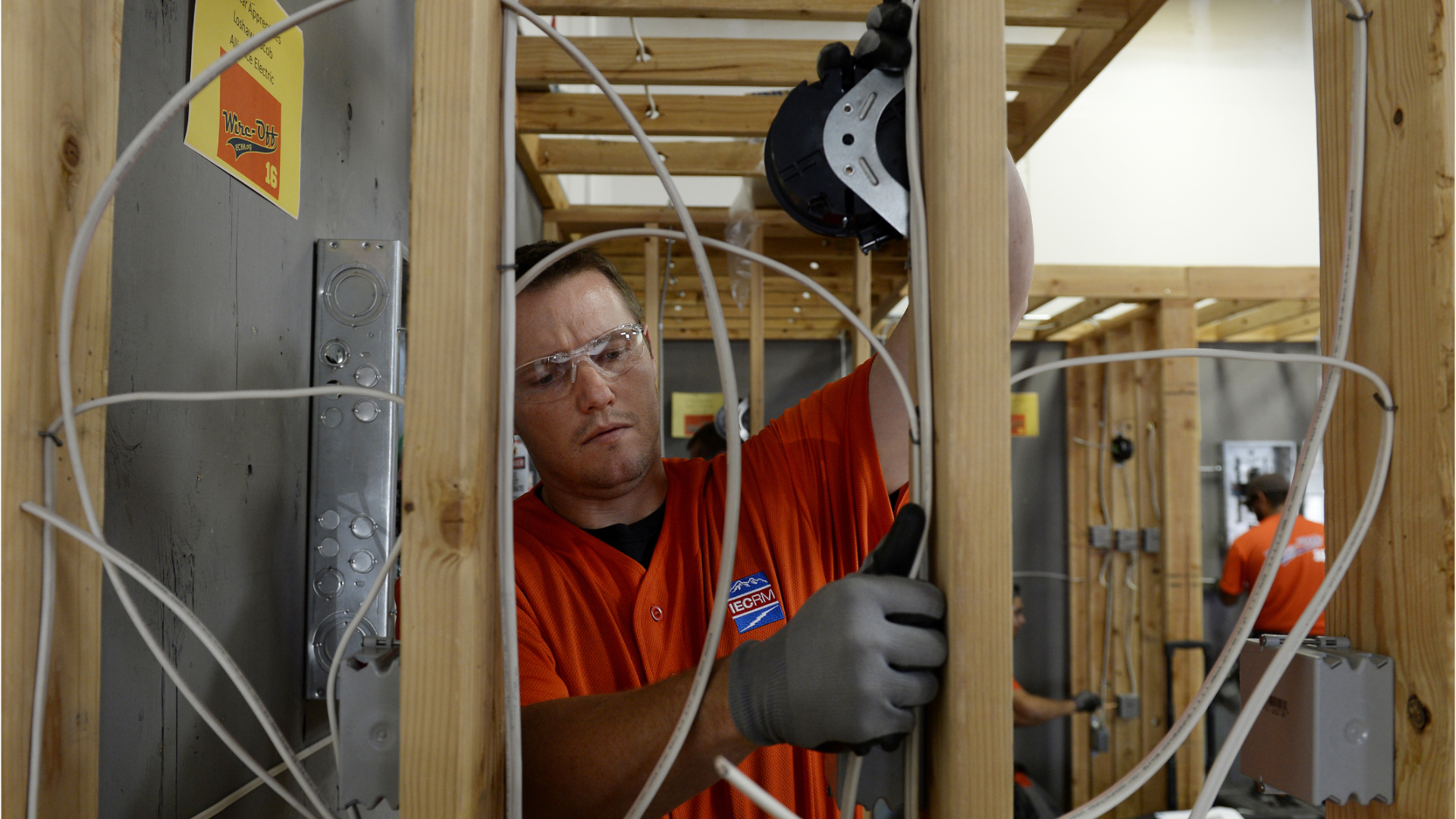Cement Mason & Concrete Finishers
Cement Mason & Concrete Finishers
Career Overview
A cement mason is a person who creates and finishes surfaces of poured concrete including driveways, floors, sidewalks, roads, and curbs.
Education
A high school diploma or equivalent is likely necessary to obtain this position. Some learn this trade through a two to four-year apprenticeship program, while others learn this on the job.
Future Outlook
Overall employment of masonry workers is projected to decline 3 percent from 2019 to 2029. The employment of masons is linked to the overall demand for new building and road construction. Masonry, such as brick and stone, is still popular in both interior and exterior applications, but changes in products and installation practices are expected to decrease the need for masons.
Work Environment
The work is physically demanding because masons lift heavy materials and often must stand, kneel, and bend for long periods. Poor weather conditions may reduce work activity because masons usually work outdoors.
Recommended High School Courses
- Drafting
- Physical education
- Blueprint reading
- Carpentry
- Construction safety
- Active Listening - Giving full attention to what other people are saying, taking time to understand the points being made, asking questions as appropriate, and not interrupting at inappropriate times.
- Complex Problem Solving - Identifying complex problems and reviewing related information to develop and evaluate options and implement solutions.
- Coordination - Adjusting actions in relation to others' actions.
- Critical Thinking - Using logic and reasoning to identify the strengths and weaknesses of alternative solutions, conclusions or approaches to problems.
- Judgment and Decision Making - Considering the relative costs and benefits of potential actions to choose the most appropriate one.
- Monitoring - Monitoring/Assessing performance of yourself, other individuals, or organizations to make improvements or take corrective action.
- Quality Control Analysis - Conducting tests and inspections of products, services, or processes to evaluate quality or performance.
- Speaking - Talking to others to convey information effectively.
- Time Management - Managing one's own time and the time of others.
- Building and Construction - Knowledge of materials, methods, and the tools involved in the construction or repair of houses, buildings, or other structures such as highways and roads.
- English Language - Knowledge of the structure and content of the English language including the meaning and spelling of words, rules of composition, and grammar.
- Mathematics - Knowledge of arithmetic, algebra, geometry, calculus, statistics, and their applications.
- Public Safety and Security - Knowledge of relevant equipment, policies, procedures, and strategies to promote effective local, state, or national security operations for the protection of people, data, property, and institutions.
- Arm-Hand Steadiness - The ability to keep your hand and arm steady while moving your arm or while holding your arm and hand in one position.
- Category Flexibility - The ability to generate or use different sets of rules for combining or grouping things in different ways.
- Control Precision - The ability to quickly and repeatedly adjust the controls of a machine or a vehicle to exact positions.
- Deductive Reasoning - The ability to apply general rules to specific problems to produce answers that make sense.
- Depth Perception - The ability to judge which of several objects is closer or farther away from you, or to judge the distance between you and an object.
- Dynamic Strength - The ability to exert muscle force repeatedly or continuously over time. This involves muscular endurance and resistance to muscle fatigue.
- Extent Flexibility - The ability to bend, stretch, twist, or reach with your body, arms, and/or legs.
- Far Vision - The ability to see details at a distance.
- Finger Dexterity - The ability to make precisely coordinated movements of the fingers of one or both hands to grasp, manipulate, or assemble very small objects.
- Gross Body Coordination - The ability to coordinate the movement of your arms, legs, and torso together when the whole body is in motion.
- Inductive Reasoning - The ability to combine pieces of information to form general rules or conclusions (includes finding a relationship among seemingly unrelated events).
- Information Ordering - The ability to arrange things or actions in a certain order or pattern according to a specific rule or set of rules (e.g., patterns of numbers, letters, words, pictures, mathematical operations).
- Manual Dexterity - The ability to quickly move your hand, your hand together with your arm, or your two hands to grasp, manipulate, or assemble objects.
- Multilimb Coordination - The ability to coordinate two or more limbs (for example, two arms, two legs, or one leg and one arm) while sitting, standing, or lying down. It does not involve performing the activities while the whole body is in motion.
- Near Vision - The ability to see details at close range (within a few feet of the observer).
- Oral Comprehension - The ability to listen to and understand information and ideas presented through spoken words and sentences.
- Oral Expression - The ability to communicate information and ideas in speaking so others will understand.
- Problem Sensitivity - The ability to tell when something is wrong or is likely to go wrong. It does not involve solving the problem, only recognizing there is a problem.
- Rate Control - The ability to time your movements or the movement of a piece of equipment in anticipation of changes in the speed and/or direction of a moving object or scene.
- Reaction Time - The ability to quickly respond (with the hand, finger, or foot) to a signal (sound, light, picture) when it appears.
- Selective Attention - The ability to concentrate on a task over a period of time without being distracted.
- Speech Clarity - The ability to speak clearly so others can understand you.
- Speech Recognition - The ability to identify and understand the speech of another person.
- Stamina - The ability to exert yourself physically over long periods of time without getting winded or out of breath.
- Static Strength - The ability to exert maximum muscle force to lift, push, pull, or carry objects.
- Trunk Strength - The ability to use your abdominal and lower back muscles to support part of the body repeatedly or continuously over time without 'giving out' or fatiguing.
- Visualization - The ability to imagine how something will look after it is moved around or when its parts are moved or rearranged.
- Inspect completed work to ensure proper installation.
- Position construction forms or molds.
- Finish concrete surfaces.
- Spread concrete or other aggregate mixtures.
- Monitor construction operations.
- Pour materials into or on designated areas.
- Signal equipment operators to indicate proper equipment positioning.
- Direct construction or extraction personnel.
- Apply sealants or other protective coatings.
- Compact materials to create level bases.
- Install masonry materials.
- Apply material to fill gaps in surfaces.
- Install building fixtures.
- Install metal structural components.
- Prepare surfaces for finishing.
- Mix substances or compounds needed for work activities.
- Apply decorative masonry finishes.
- Smooth surfaces with abrasive materials or tools.
- Break up rock, asphalt, or concrete.
- Drill holes in construction materials.
- Position structural components.
- Fabricate parts or components.
- Clean surfaces in preparation for work activities.
- Build construction forms or molds.
- Cut metal components for installation.
- Install roofing materials.
Potential Scholarships
Approx Salary Expectation
Related Careers
References
Trend Analysis - Explorer the Market, Labour Market Information, Government of Canada https://www.jobbank.gc.ca/trend-analysis.
O*NET OnLine, National Center for O*NET Development, https://www.onetonline.org/.


